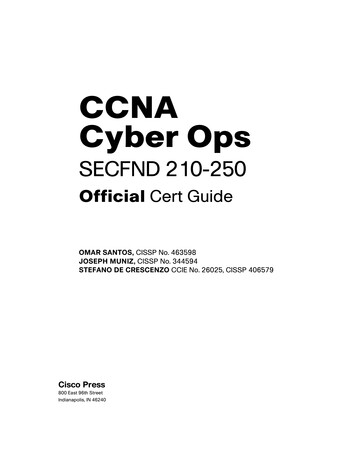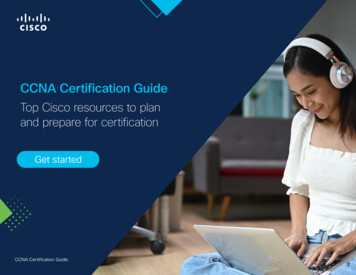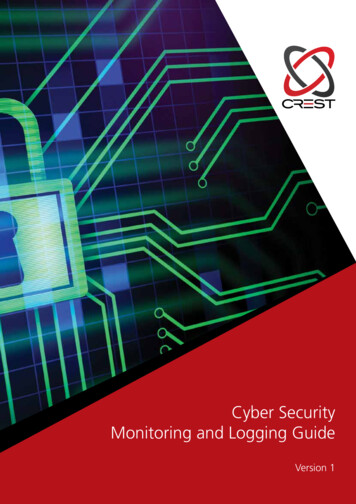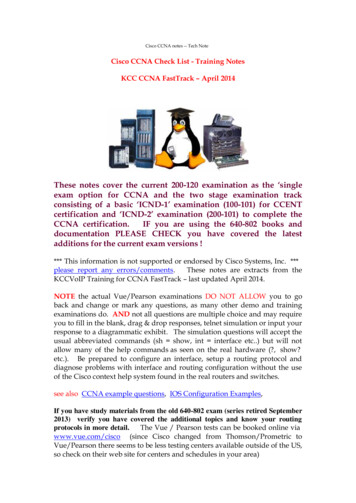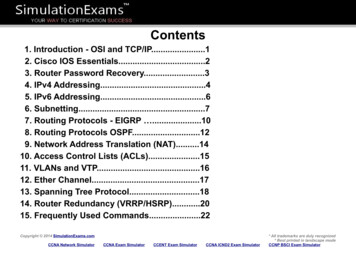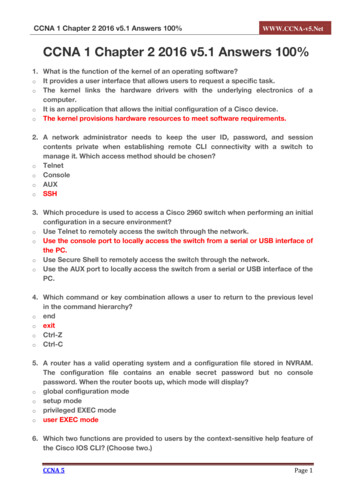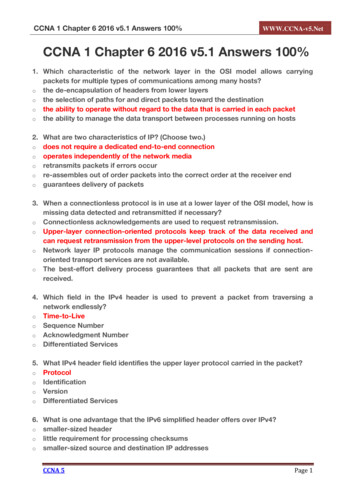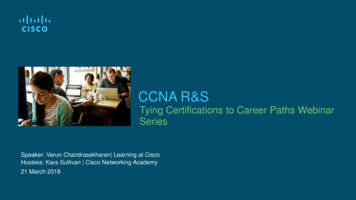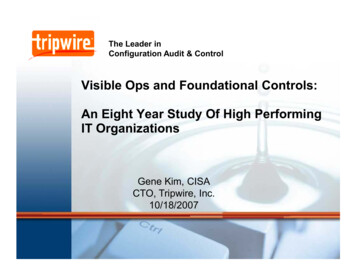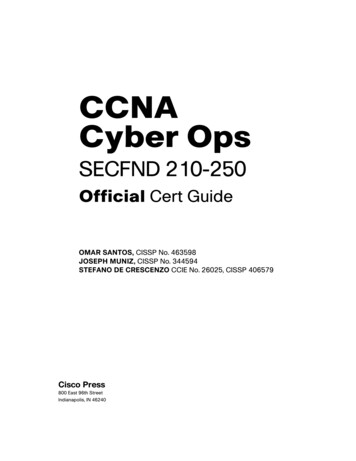
Transcription
CCNACyber OpsSECFND 210-250Official Cert GuideOMAR SANTOS, CISSP No. 463598JOSEPH MUNIZ, CISSP No. 344594STEFANO DE CRESCENZO CCIE No. 26025, CISSP 406579Cisco Press800 East 96th StreetIndianapolis, IN 462409781587147029 BOOK.indb i3/8/17 12:44 PM
iiCCNA Cyber Ops SECFND 210-250 Official Cert GuideCCNA Cyber Ops SECFND 210-250Official Cert GuideOmar SantosJoseph MunizStefano De CrescenzoCopyright 2017 Pearson Education, Inc.Published by:Cisco Press800 East 96th StreetIndianapolis, IN 46240 USAAll rights reserved. No part of this book may be reproduced or transmitted in any form or by any means,electronic or mechanical, including photocopying, recording, or by any information storage and retrievalsystem, without written permission from the publisher, except for the inclusion of brief quotations in areview.Printed in the United States of America117Library of Congress Control Number: 2017931952ISBN-10: 1-58714-702-5ISBN-13: 978-1-58714-702-9Warning and DisclaimerThis book is designed to provide information about the CCNA Cyber Ops SECFND #210-250 exam.Every effort has been made to make this book as complete and accurate as possible, but no warranty orfitness is implied.The information is provided on an “as is” basis. The authors, Cisco Press, and Cisco Systems, Inc., shallhave neither liability nor responsibility to any person or entity with respect to any loss or damagesarising from the information contained in this book or from the use of the discs or programs that mayaccompany it.The opinions expressed in this book belong to the authors and are not necessarily those of CiscoSystems, Inc.9781587147029 BOOK.indb ii3/8/17 12:44 PM
iiiTrademark AcknowledgmentsAll terms mentioned in this book that are known to be trademarks or service marks have been appropriately capitalized. Cisco Press or Cisco Systems, Inc., cannot attest to the accuracy of this information.Use of a term in this book should not be regarded as affecting the validity of any trademark or servicemark.Special SalesFor information about buying this title in bulk quantities, or for special sales opportunities (which mayinclude electronic versions; custom cover designs; and content particular to your business, training goals,marketing focus, or branding interests), please contact our corporate sales department at corpsales@pearsoned.com or (800) 382-3419.For government sales inquiries, please contact governmentsales@pearsoned.com.For questions about sales outside the United States, please contact intlcs@pearson.com.Feedback InformationAt Cisco Press, our goal is to create in-depth technical books of the highest quality and value. Each bookis crafted with care and precision, undergoing rigorous development that involves the unique expertiseof members from the professional technical community.Readers’ feedback is a natural continuation of this process. If you have any comments regarding how wecould improve the quality of this book, or otherwise alter it to better suit your needs, you can contact usthrough email at feedback@ciscopress.com. Please make sure to include the book title and ISBN in yourmessage.We greatly appreciate your assistance.Editor-in-Chief: Mark TaubAlliances Manager, Cisco Press: Ron FliggeProduct Line Manager: Brett BartowExecutive Editor: Mary Beth RayManaging Editor: Sandra SchroederTechnical Editors: Pavan Reddy, Ron TaylorDevelopment Editor: Christopher ClevelandCopy Editor: Bart ReedProject Editor: Mandie FrankDesigner: Chuti PrasertsithComposition: Tricia BronkellaEditorial Assistant: Vanessa EvansIndexer: Ken JohnsonProofreader: The Wordsmithery LLC9781587147029 BOOK.indb iii3/8/17 12:44 PM
ivCCNA Cyber Ops SECFND 210-250 Official Cert GuideAbout the AuthorsOmar Santos is an active member of the cyber security community, where he leadsseveral industry-wide initiatives and standards bodies. His active role helps businesses,academic institutions, state and local law enforcement agencies, and other participantsdedicated to increasing the security of their critical infrastructures.Omar is the author of over a dozen books and video courses, as well as numerous whitepapers, articles, and security configuration guidelines and best practices. Omar is a principal engineer of the Cisco Product Security Incident Response Team (PSIRT), where hementors and leads engineers and incident managers during the investigation and resolution of cyber security vulnerabilities. Additional information about Omar’s current projects can be found at omarsantos.io, and you can follow Omar on Twitter @santosomar.Joseph Muniz is an architect at Cisco Systems and security researcher. He has extensiveexperience in designing security solutions and architectures for the top Fortune 500corporations and the U.S. government. Joseph’s current role gives him visibility into thelatest trends in cyber security, from both leading vendors and customers. Examples ofJoseph’s research include his RSA talk titled “Social Media Deception,” which has beenquoted by many sources (search for “Emily Williams Social Engineering”), as well as hisarticles in PenTest Magazine regarding various security topics.Joseph runs The Security Blogger website, a popular resource for security, hacking,and product implementation. He is the author and contributor of several publicationscovering various penetration testing and security topics. You can follow Joseph at www.thesecurityblogger.com and @SecureBlogger.Stefano De Crescenzo is a senior incident manager with the Cisco Product SecurityIncident Response Team (PSIRT), where he focuses on product vulnerability management and Cisco products forensics. He is the author of several blog posts and whitepapers about security best practices and forensics. He is an active member of the security community and has been a speaker at several security conferences.Stefano specializes in malware detection and integrity assurance in critical infrastructuredevices, and he is the author of integrity assurance guidelines for Cisco IOS, IOS-XE,and ASA.Stefano holds a B.Sc. and M.Sc. in telecommunication engineering from Politecnico diMilano, Italy, and an M.Sc. in telecommunication from Danish Technical University,Denmark. He is currently pursuing an Executive MBA at Vlerick Business School inBelgium. He also holds a CCIE in Security #26025 and is CISSP and CISM certified.9781587147029 BOOK.indb iv3/8/17 12:44 PM
vAbout the Technical ReviewersPavan Reddy serves as a Security Principal in Cisco Security Services. Pavan has 20 years of security and network consulting experience in Financial Services, Healthcare,Service Provider, and Retail arenas. Recent projects cover Technical Security Strategyand Architecture, Network Segmentation Strategy, Threat Intelligence Analytics,Distributed Denial-of-Service Mitigation Architectures, and DNS Architecture andSecurity. Pavan holds multiple CCIEs and BS in Computer Engineering.Ron Taylor has been in the Information Security field for almost 20 years. Ten of thoseyears were spent in consulting where he gained experience in many areas. In 2008, hejoined the Cisco Global Certification Team as an SME in Information Assurance. In2012, he moved into a position with the Security Research & Operations group (PSIRT),where his focus was mostly on penetration testing of Cisco products and services. Hewas also involved in developing and presenting security training to internal developmentand test teams globally. Additionally, he provided consulting support to many product teams as an SME on product security testing. In his current role, he is a ConsultingSystems Engineer specializing in Cisco’s security product line. Certifications includeGPEN, GWEB, GCIA, GCIH, GWAPT, RHCE, CCSP, CCNA, CISSP, and MCSE. Ron isalso a Cisco Security Blackbelt, SANS mentor, Cofounder and President of the RaleighBSides Security Conference, and a member of the Packet Hacking Village team atDefcon.9781587147029 BOOK.indb v3/8/17 12:44 PM
viCCNA Cyber Ops SECFND 210-250 Official Cert GuideDedicationsI would like to dedicate this book to my lovely wife, Jeannette, and my two beautifulchildren, Hannah and Derek, who have inspired and supported me throughout the development of this book.I also dedicate this book to my father, Jose, and to the memory of my mother, Generosa.Without their knowledge, wisdom, and guidance, I would not have the goals that I striveto achieve today.—Omar SantosI would like to dedicate this book to the memory of my father, Raymond Muniz. Henever saw me graduate from college or accomplish great things, such as writing thisbook. I would also like to apologize to him for dropping out of soccer in high school. Ipicked it back up later in life, and today play in at least two competitive matches a week.Your hard work paid off. Hopefully you somehow know that.—Joseph MunizThis book is dedicated to my wife, Nevena, and my beautiful daughters, Sara and Tea,who supported and inspired me during the development of this book. Specifically, Teawas born a few weeks before I started writing my first chapter, so she is especially connected with this book.I would also like to mention my whole family: my mother, Mariagrazia, and my sister,Francesca, who supported my family and me while I was away writing. I also dedicatethis book to the memory of my father, Cataldo.—Stefano De Crescenzo9781587147029 BOOK.indb vi3/8/17 12:44 PM
viiAcknowledgmentsI would like to thank the technical editors, Pavan Reddy and Ron Taylor, for their timeand technical expertise. They verified our work and contributed to the success of thisbook. I would also like to thank the Cisco Press team, especially Mary Beth Ray, DeniseLincoln, and Christopher Cleveland, for their patience, guidance, and consideration.Their efforts are greatly appreciated. Finally, I would like to acknowledge the CiscoSecurity Research and Operations teams, Cisco Advanced Threat Analytics, and CiscoTalos. Several leaders in the network security industry work there, supporting our Ciscocustomers, often under very stressful conditions, and working miracles daily. They aretruly unsung heroes, and I am honored to have had the privilege of working side by sidewith them in the trenches while protecting customers and Cisco.—Omar SantosI would first like to thank Omar and Stefano for including me on this project. I reallyenjoyed working with these guys and hope we can do more in the future. I also wouldlike to thank the Cisco Press team and technical editors, Pavan Reddy and Ron Taylor,for their fantastic support in making the writing process top quality and easy for everybody. Hey, Ron, you got this and the CTR comic. 2016 was great for you, Mr. Green.I would also like to thank all the great people in my life who make me who I am.Finally, a message for Raylin Muniz (age 7): Hopefully one day you can accomplish yourdreams like I have with this book.—Joseph MunizI would like to thank Omar and Joey for being fantastic mates in the development ofthis book. A special mention goes to my wife as well, for supporting me throughout thisjourney and for helping me by reviewing my work.Additionally, this book wouldn’t have been possible without the help of the Cisco Pressteam and in particular of Chris Cleveland. His guidance has been very precious. A bigthanks goes to the technical reviewers, Pavan and Ron. Thanks for keeping me honestand to the point! A big thanks also to Eric Vyncke for his numerous suggestions.—Stefano De Crescenzo9781587147029 BOOK.indb vii3/8/17 12:44 PM
viiiCCNA Cyber Ops SECFND 210-250 Official Cert GuideContents at a GlanceIntroductionxxvPart INetwork ConceptsChapter 1Fundamentals of Networking Protocols and Networking DevicesChapter 2Network Security Devices and Cloud ServicesPart IISecurity ConceptsChapter 3Security PrinciplesChapter 4Introduction to Access ControlsChapter 5Introduction to Security Operations ManagementPart IIICryptographyChapter 6Fundamentals of Cryptography and Public Key Infrastructure (PKI)Chapter 7Introduction to Virtual Private Networks (VPNs)Part IVHost-Based AnalysisChapter 8Windows-Based AnalysisChapter 9Linux- and Mac OS X–Based AnalysisChapter 10Endpoint Security Technologies 403Part VSecurity Monitoring and Attack MethodsChapter 11Network and Host TelemetryChapter 12Security Monitoring Operational Challenges 487Chapter 13Types of Attacks and Vulnerabilities 499Chapter 14Security Evasion Techniques 523Part VIFinal PreparationChapter 15Final Preparation 5459781587147029 BOOK.indb viii31091591852413093393573794193/8/17 12:44 PM
ixPart VIIAppendixesAppendix AAnswers to the “Do I Know This Already?” Quizzes and Q&AQuestions 551Glossary 571Index 586Elements Available on the Book WebsiteAppendix BMemory TablesAppendix CMemory Tables Answer KeyAppendix DStudy Planner9781587147029 BOOK.indb ix3/8/17 12:44 PM
xCCNA Cyber Ops SECFND 210-250 Official Cert GuideContentsIntroduction xxvPart INetwork ConceptsChapter 1Fundamentals of Networking Protocols and Networking Devices“Do I Know This Already?” Quiz33Foundation Topics 6TCP/IP and OSI Model 6TCP/IP Model 6TCP/IP Model Encapsulation 9Networking Communication with the TCP/IP Model 10Open System Interconnection Model 12Layer 2 Fundamentals and Technologies 16Ethernet LAN Fundamentals and Technologies 16Ethernet Physical Layer 16Ethernet Medium Access Control 17Ethernet Frame 19Ethernet Addresses 19Ethernet Devices and Frame-Forwarding Behavior 20LAN Hubs and Bridges 20LAN Switches 22Link Layer Loop and Spanning Tree Protocols 26Virtual LAN (VLAN) and VLAN Trunking 31Cisco VLAN Trunking Protocol 33Inter-VLAN Traffic and Multilayer Switches 33Wireless LAN Fundamentals and Technologies 35802.11 Architecture and Basic Concepts 37802.11 Frame 39WLAN Access Point Types and Management 40Internet Protocol and Layer 3 Technologies 43IPv4 Header 45IPv4 Fragmentation 47IPv4 Addresses and Addressing Architecture 48IP Network Subnetting and Classless Interdomain Routing (CIDR) 50Variable-Length Subnet Mask (VLSM) 52Public and Private IP Addresses 54Special and Reserved IPv4 Addresses 569781587147029 BOOK.indb x3/8/17 12:44 PM
xiIP Addresses Assignment and DHCP 57IP Communication Within a Subnet and Address Resolution Protocol(ARP) 60Intersubnet IP Packet Routing 61Routing Tables and IP Routing Protocols 64Distance Vector 65Advanced Distance Vector or Hybrid 67Link-State 67Using Multiple Routing Protocols 69Internet Control Message Protocol (ICMP) 69Domain Name System (DNS) 71IPv6 Fundamentals 75IPv6 Header 78IPv6 Addressing and Subnets 79Special and Reserved IPv6 Addresses 82IPv6 Addresses Assignment, Neighbor Discovery Protocol, andDHCPv6 83Transport Layer Technologies and Protocols 89Transmission Control Protocol (TCP) 90TCP Header91TCP Connection Establishment and TerminationTCP Socket9294TCP Error Detection and RecoveryTCP Flow Control9597User Datagram Protocol (UDP) 98UDP Header98UDP Socket and Known UDP Application99Exam Preparation Tasks 100Review All Key Topics 100Complete Tables and Lists from Memory 103Define Key Terms 103Q&A103References and Further Reading 1069781587147029 BOOK.indb xi3/8/17 12:44 PM
xiiCCNA Cyber Ops SECFND 210-250 Official Cert GuideChapter 2Network Security Devices and Cloud Services“Do I Know This Already?” Quiz109109Foundation Topics 112Network Security Systems 112Traditional Firewalls 112Packet-Filtering Techniques 113Application Proxies 117Network Address Translation 117Port Address Translation 118Static Translation 119Stateful Inspection Firewalls 120Demilitarized Zones 120Firewalls Provide Network Segmentation 120High Availability121Firewalls in the Data CenterVirtual Firewalls123124Deep Packet Inspection125Next-Generation Firewalls 126Cisco Firepower Threat Defense 126Personal Firewalls 128Intrusion Detection Systems and Intrusion Prevention Systems 128Pattern Matching and Stateful Pattern-Matching Recognition 130Protocol Analysis 131Heuristic-Based Analysis 131Anomaly-Based Analysis 131Global Threat Correlation Capabilities 132Next-Generation Intrusion Prevention Systems 133Firepower Management Center 133Advance Malware Protection 133AMP for Endpoints133AMP for Networks136Web Security Appliance 137Email Security Appliance 140Cisco Security Management Appliance 142Cisco Identity Services Engine 1439781587147029 BOOK.indb xii3/8/17 12:44 PM
xiiiSecurity Cloud-based Solutions 144Cisco Cloud Web Security 145Cisco Cloud Email Security 146Cisco AMP Threat Grid 147Cisco Threat Awareness Service 147OpenDNS148CloudLock 148Cisco NetFlow149What Is the Flow in NetFlow?NetFlow vs. Full Packet CaptureThe NetFlow CacheData Loss Prevention149151151152Exam Preparation Tasks153Review All Key Topics153Complete Tables and Lists from MemoryDefine Key TermsQ&A154154154Part IISecurity ConceptsChapter 3Security Principles 159“Do I Know This Already?” Quiz 159Foundation Topics 162The Principles of the Defense-in-Depth Strategy 162What Are Threats, Vulnerabilities, and Exploits? 166Vulnerabilities 166Threats 167Threat Actors168Threat Intelligence168Exploits 170Confidentiality, Integrity, and Availability: The CIA Triad 171Confidentiality 171Integrity 171Availability 171Risk and Risk Analysis 171Personally Identifiable Information and Protected Health Information 173PIIPHI9781587147029 BOOK.indb xiii1731743/8/17 12:44 PM
xivCCNA Cyber Ops SECFND 210-250 Official Cert GuidePrinciple of Least Privilege and Separation of Duties 174Principle of Least Privilege 174Separation of Duties 175Security Operation Centers 175Runbook Automation 176Forensics 177Evidentiary Chain of Custody 177Reverse Engineering 178Exam Preparation Tasks 180Review All Key Topics 180Define Key Terms 180Q&AChapter 4181Introduction to Access Controls“Do I Know This Already?” Quiz185185Foundation Topics 189Information Security Principles 189Subject and Object Definition 189Access Control Fundamentals 190Identification 190Authentication 191Authentication by Knowledge 191Authentication by Ownership 191Authentication by Characteristic 191Multifactor Authentication 192Authorization 193Accounting 193Access Control Fundamentals: Summary 194Access Control Process 195Asset Classification 195Asset Marking 196Access Control Policy 197Data Disposal 197Information Security Roles and Responsibilities 197Access Control Types 199Access Control Models 201Discretionary Access Control 203Mandatory Access Control 2049781587147029 BOOK.indb xiv3/8/17 12:44 PM
xvRole-Based Access Control 205Attribute-Based Access Control 207Access Control Mechanisms 210Identity and Access Control Implementation 212Authentication, Authorization, and Accounting Protocols 212RADIUS212TACACS 214Diameter216Port-Based Access Control 218Port Security218802.1x 219Network Access Control List and Firewalling 221VLAN Map 222Security Group–Based ACL222Downloadable ACL 222Firewalling 223Identity Management and Profiling 223Network Segmentation 223Network Segmentation Through VLAN 224Firewall DMZ 225Cisco TrustSec 225Intrusion Detection and Prevention 227Network-Based Intrusion Detection and Protection System 229Host-Based Intrusion Detection and Prevention 230Antivirus and Antimalware 231Exam Preparation Tasks 233Review All Key Topics 233Complete Tables and Lists from Memory 234Define Key Terms 234Q&A234References and Additional Reading 237Chapter 5Introduction to Security Operations Management“Do I Know This Already?” Quiz241241Foundation Topics 244Introduction to Identity and Access Management 244Phases of the Identity and Access Lifecycle 244Registration and Identity Validation 245Privileges Provisioning 2459781587147029 BOOK.indb xv3/8/17 12:44 PM
xviCCNA Cyber Ops SECFND 210-250 Official Cert GuideAccess Review246Access Revocation246Password Management 246Password Creation246Password Storage and TransmissionPassword Reset248249Password Synchronization249Directory Management 250Single Sign-OnKerberos252253Federated SSO 255Security Assertion Markup Language 256OAuth258OpenID Connect259Security Events and Logs Management 260Logs Collection, Analysis, and Disposal 260Syslog262Security Information and Event Manager 264Assets Management 265Assets Inventory 266Assets Ownership 267Assets Acceptable Use and Return Policies 267Assets Classification 268Assets Labeling 268Assets and Information Handling 268Media Management 269Introduction to Enterprise Mobility Management 269Mobile Device Management 271Cisco BYOD Architecture 272Cisco ISE and MDM Integration 274Cisco Meraki Enterprise Mobility Management 276Configuration and Change Management 276Configuration Management 276Change Management 2789781587147029 BOOK.indb xvi3/8/17 12:44 PM
xviiVulnerability Management 281Vulnerability Identification 281Finding Information about a Vulnerability 282Vulnerability Scan 284Penetration Assessment 285Product Vulnerability Management 286Vulnerability Analysis and Prioritization 290Vulnerability Remediation 294Patch Management 295References and Additional Readings 299Exam Preparation Tasks 302Review All Key Topics 302Complete Tables and Lists from Memory 303Define Key Terms 303Q&A303Part IIICryptographyChapter 6Fundamentals of Cryptography and Public Key Infrastructure(PKI) 309“Do I Know This Already?” Quiz309Foundation Topics 311Cryptography 311Ciphers and Keys 311CiphersKeys311312Block and Stream Ciphers 312Symmetric and Asymmetric Algorithms 313Symmetric Algorithms 313Asymmetric Algorithms 313Hashes 314Hashed Message Authentication Code 316Digital Signatures 317Digital Signatures in Action 317Key Management320Next-Generation Encryption Protocols 321IPsec and SSL 321IPsecSSL9781587147029 BOOK.indb xvii3213223/8/17 12:44 PM
xviiiCCNA Cyber Ops SECFND 210-250 Official Cert GuideFundamentals of PKI 323Public and Private Key Pairs 323RSA Algorithm, the Keys, and Digital Certificates 324Certificate Authorities 324Root and Identity Certificates 326Root Certificate326Identity Certificate327X.500 and X.509v3 Certificates328Authenticating and Enrolling with the CA 328Public Key Cryptography Standards 330Simple Certificate Enrollment Protocol 330Revoking Digital Certificates 330Using Digital Certificates 331PKI Topologies 331Single Root CA 332Hierarchical CA with Subordinate CAs 332Cross-certifying CAs 333Exam Preparation Tasks 334Review All Key Topics 334Complete Tables and Lists from Memory 334Define Key Terms 335Q&AChapter 7335Introduction to Virtual Private Networks (VPNs)“Do I Know This Already?” Quiz339339Foundation Topics 341What Are VPNs?341Site-to-site vs. Remote-Access VPNs 341An Overview of IPsec 343IKEv1 Phase 1 343IKEv1 Phase 2 345IKEv2SSL VPNs348348SSL VPN Design ConsiderationsUser Connectivity351351VPN Device Feature Set351Infrastructure Planning 352Implementation Scope 3529781587147029 BOOK.indb xviii3/8/17 12:44 PM
xixExam Preparation Tasks 353Review All Key Topics 353Complete Tables and Lists from Memory 353Define Key Terms 353Q&A353Part IVHost-Based AnalysisChapter 8Windows-Based Analysis 357“Do I Know This Already?” Quiz 357Foundation Topics 360Process and Threads 360Memory Allocation 362Windows Registration 364Windows Management Instrumentation 366Handles 368Services 369Windows Event Logs 372Exam Preparation Tasks 375Review All Key Topics 375Define Key Terms 375Q&A375References and Further Reading 377Chapter 9Linux- and Mac OS X–Based Analysis 379“Do I Know This Already?” Quiz 379Foundation Topics 382Processes 382Forks384Permissions 385Symlinks 390Daemons 391UNIX-Based Syslog 392Apache Access Logs 396Exam Preparation Tasks 398Review All Key Topics 398Complete Tables and Lists from Memory 398Define Key Terms 398Q&A399References and Further Reading 4009781587147029 BOOK.indb xix3/8/17 12:44 PM
xxCCNA Cyber Ops SECFND 210-250 Official Cert GuideChapter 10Endpoint Security Technologies 403“Do I Know This Already?” Quiz 403Foundation Topics 406Antimalware and Antivirus Software 406Host-Based Firewalls and Host-Based Intrusion Prevention 408Application-Level Whitelisting and Blacklisting 410System-Based Sandboxing 411Exam Preparation Tasks 414Review All Key Topics 414Complete Tables and Lists from Memory 414Define Key Terms 414Q&A414Part VSecurity Monitoring and Attack MethodsChapter 11Network and Host Telemetry419“Do I Know This Already?” Quiz419Foundation Topics 422Network Telemetry 422Network Infrastructure Logs 422Network Time Protocol and Why It Is Important 423Configuring Syslog in a Cisco Router or Switch 424Traditional Firewall Logs 426Console LoggingTerminal LoggingASDM LoggingEmail Logging427427427427Syslog Server LoggingSNMP Trap Logging427428Buffered Logging 428Configuring Logging on the Cisco ASA 428Syslog in Large Scale Environments 430SplunkGraylog430434Elasticsearch, Logstash, and Kibana (ELK) Stack 436Next-Generation Firewall and Next-Generation IPS Logs 437NetFlow Analysis 445Commercial NetFlow Analysis Tools 447Open Source NetFlow Analysis Tools 449Counting, Grouping, and Mating NetFlow Records with Silk 4539781587147029 BOOK.indb xx3/8/17 12:44 PM
xxiBig Data Analytics for Cyber Security Network Telemetry 453Configuring Flexible NetFlow in Cisco IOS and Cisco IOS-XEDevices 455Cisco Application Visibility and Control (AVC) 469Network Packet Capture 470tcpdump 471Wireshark 473Cisco Prime Infrastructure 474Host Telemetry 477Logs from User Endpoints 477Logs from Servers 481Exam Preparation Tasks 483Review All Key Topics 483Complete Tables and Lists from Memory 483Define Key Terms 483Q&AChapter 12484Security Monitoring Operational Challenges 487“Do I Know This Already?” Quiz487Foundation Topics 490Security Monitoring and Encryption 490Security Monitoring and Network Address Translation 491Security Monitoring and Event Correlation Time Synchronization 491DNS Tunneling and Other Exfiltration Methods 491Security Monitoring and Tor 493Security Monitoring and Peer-to-Peer Communication 494Exam Preparation Tasks 495Review All Key Topics 495Define Key Terms 495Q&AChapter 13495Types of Attacks and Vulnerabilities 499“Do I Know This Already?” Quiz 499Foundation Topics 502Types of Attacks 502Reconnaissance Attacks 502Social Engineering 504Privilege Escalation Attacks 506Backdoors 5069781587147029 BOOK.indb xxi3/8/17 12:44 PM
xxiiCCNA Cyber Ops SECFND 210-250 Official Cert GuideCode Execution506Man-in-the Middle Attacks506Denial-of-Service Attacks 507Direct DDoS507Botnets Participating in DDoS AttacksReflected DDoS Attacks508509Attack Methods for Data Exfiltration 510ARP Cache Poisoning 511Spoofing Attacks 512Route Manipulation Attacks 513Password Attacks 513Wireless Attacks 514Types of Vulnerabilities 514Exam Preparation Tasks 518Review All Key Topics 518Define Key Terms 518Q&AChapter 14518Security Evasion Techniques 523“Do I Know This Already?” Quiz 523Foundation Topics 526Encryption and Tunneling 526Key Encryption and Tunneling Concepts 531Resource Exhaustion 531Traffic Fragmentation 532Protocol-Level Misinterpretation 533Traffic Timing, Substitution, and Insertion 535Pivoting 536Exam Preparation Tasks 541Review All Key Topics 541Complete Tables and Lists from Memory 541Define Key Terms 541Q&A541References and Further Reading 5439781587147029 BOOK.indb xxii3/8/17 12:44 PM
xxiiiPart VIFinal PreparationChapter 15Final Preparation 545Tools for Final Preparation 545Pearson Cert Practice Test Engine and Questions on the Website 545Accessing the Pearson Test Prep Software Online 545Accessing the Pearson Test Prep Software Offline 546Customizing Your Exams 547Updating Your Exams 547Premium Edition548The Cisco Learning Network 548Memory Tables 548Chapter-Ending Review Tools 549Suggested Plan for Final Review/Study 549Summary549Part VIIAppendixesAppendix AAnswers to the “Do I Know This Already?” Quizzes and Q&AQuestions 551Glossary 571Index 586Elements Available on the Book WebsiteAppendix BMemory TablesAppendix CMemory Tables Answer KeyAppendix DStudy Planner9781587147029 BOOK.indb xxiii3/8/17 12:44 PM
xxivCCNA Cyber Ops SECFND 210-250 Official Cert GuideCommand Syntax ConventionsThe conventions used to present command syntax in this book are the same conventionsused in the IOS Command Reference. The Command Reference describes these conventions as follows: Bold indicates commands and keywords that are entered literally as shown. In actualconfiguration examples and output (not general command syntax), bold indicates commands that are manually input by the user (such as a show command). Italic indicates arguments for which you supply actual values. Vertical bars ( ) separate alternative, mutually exclusive elements. Square brackets ([ ]) indicate an optional element. Braces ({ }) indicate a required choice. Braces within brackets ([{ }]) indicate a required choice within an optional element.9781587147029 BOOK.indb xxiv3/8/17 12:44 PM
xxvIntroductionCongratulations! If you are reading this, you have in your possession a powerful tool thatcan help you to: Improve your awareness and knowledge of cyber security fundamentals Increase your skill level related to the implementation of that security Prepare for the CCNA Cyber Ops SECFND certification examWhether you are preparing for the CCNA Cyber Ops certification or just changing careersto cyber security, this book will help you gain the knowledge you need to get startedand prepared. When writing this book, we did so with you in mind, and together we willdiscover the critical ingredients that make up the recipe for a secure network and howto succeed in cyber security operations. By focusing on covering the objectives for theCCNA Cyber Ops SECFND exam and integrating that with real-world best practices andexamples, we created this content with the intention of being your personal tour guides aswe take you on a journey through the world of network security.The CCNA Cyber Ops: Understanding Cisco Cybersecurity Fundamentals (SECFND) 210250 exam is required for the CCNA Cyber Ops certification. This book covers all the topics listed in Cisco’s exam blueprint, and each chapter includes key topics and preparationtasks to assist you in mastering this information. Reviewing tables and
He is currently pursuing an Executive MBA at Vlerick Business School in Belgium. He also holds a CCIE in Security #26025 and is CISSP and CISM certified. iv CCNA Cyber Ops SECFND 210-250 Official
